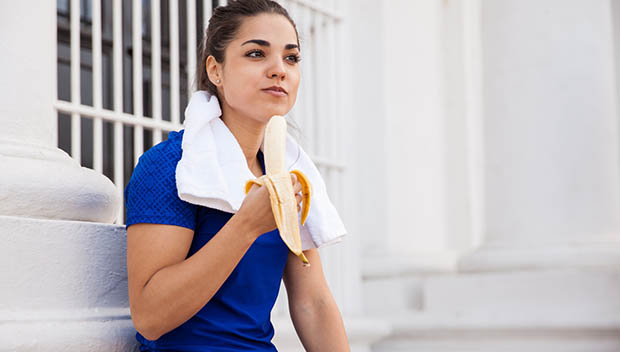
Many runners never have to worry about eating on the run, but if you're training for a longer-distance event, you may be what you need to consume to make it to the end. If you aren't exactly sure about what, when or how to replenish your body's waning fuel stores, we've got all the details.
What Your Body Needs
To keep your muscles firing and your legs turning over mile after mile, your body needs to replace the water and electrolytes lost in your sweat, as well as some quick-digesting calories to top up your depleted glycogen stores. While you'll probably need to rehydrate on shorter runs—depending on heat, humidity and your personal sweat rate—you'll also need to replenish electrolytes and glycogen on runs lasting two hours or more.
It's important to note that on longer runs, you'll need to begin refueling long before the two-hour mark to allow your body time to digest and absorb what you're consuming. While everyone's needs are different—and your individual needs might vary from one workout to the next—a good rule of thumb is to take in around 20 ounces of fluid, some electrolytes and around 150 to 250 calories every 30 minutes.
For simplicity's sake, you might opt to get your fluids, electrolytes and calories all in the form of a sports drink, or you may prefer to wash down your gels, chews, beans with plain water. If you're opposed to the artificial colors and other chemical ingredients in many of these commercial products, or if you just like knowing exactly what you put into your body, you may opt for real food instead.
A single Medjool date will give you 65 calories of simple sugars and twice as much potassium as a 20-ounce bottle of the leading sports drink, but you'll need to pair that with something salty, like dill pickles or olives, which are both high in sodium and chloride. Coconut water is naturally high in potassium, magnesium and sodium and supplies around 50 calories (of mostly sugar) per 8-ounce serving. Whatever you choose to eat and/or drink, be sure to practice with it in training multiple times before race day to see how effective it is and whether your GI system tolerates it.
MORE: 10 Quality Breakfasts to Fuel Your Long Run
How to Carry All That Fuel
Once you've figured out what and when to eat and drink, the next obvious question is how to carry all those calories and fluids on a long run. Fortunately, sports gear manufacturers have given us many options to choose from.
For carrying water and other liquids, you can run with a bottle strapped to your hand or use a belt around your waist that holds multiple small bottles; you can also sip from a hydration pack strapped to your back. None of these are as comfortable as running without pounds and pounds of fluid attached to your body, but with practice, you'll get used to it.
In the food department, there are also many options. If you run with gels, chews, beans or other small food packs, you can stash them into the pockets of your running shorts (RaceReady is one popular brand), fuel belts or for very long "expedition" runs, into a Camelbak or similar hydration pack's extra pouches. If you prefer to eat solid food (like PB&J sandwiches, dill pickles or potato chips that are so popular with ultra runners), a waist pack or small backpack are your best bet.
MORE: The Most Popular Post-Run Fuel
Think Outside the Pack
While running gear is always fun to buy and try, it is possible—and a lot more comfortable—to complete a long training run without carrying fuel or fluids with you. The downside is that this requires you to pre-stash those necessities before you run.
The easiest way to do this is to simply choose a long loop course (running around a lake is always a good option if available) and have your food and fluids in your car. Every time you complete a loop, stop at your very own aid station to eat and drink.
For out-and-back routes, you'll have to get more creative to be sure your stash is still there when you get to it. Using a camouflaged bag to stow your vittles is one way to hide them from curious passers-by. Just make sure you pay attention to exactly where you place it or you may miss it yourself!
Next time you head out on a long run, don't risk dehydration or the dreaded two-hour bonk. Instead, bring what you need along to ensure that you have a safe, effective workout.
READ THIS NEXT: Best Ways to Refuel After a Hard Run


